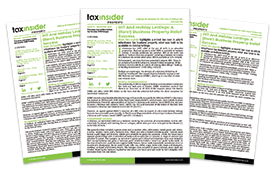Before you go, sign up to our free tax saving email course. Get 7 top property tax saving strategies in your email inbox that will help you save thousands in tax. Unsubscribe any time.
|
Most individuals owning a house will be aware of the principal private residence (PPR) relief rules for capital gains tax purposes. The PPR rules require that the dwelling has been occupied as the individual’s only or main residence at some point during their period of ownership (TCGA 1992, s 222(1)). Two fundamental requirements sometimes overlooked are occupation and residence. Occupied as a residence? Secondly, the property must be occupied as a residence. Numerous tribunal and court cases have considered what constitutes a ‘residence’. HMRC’s view is that: “the test of residence is one of quality rather than quantity” (CG64427). Prove it For example, in Simpson v Revenue and Customs [2019] UKFTT 704 (TC), the taxpayer had lived in a property since 2001. On 5 June 2013, she purchased another property (ECS). ECS was sold on 29 November 2013 at a gain. The taxpayer claimed PPR on the basis that ECS was her only or main residence throughout her period of ownership. However, the First-tier Tribunal (FTT) considered that inconsistencies in the taxpayer’s testimony made her evidence unreliable. Furthermore, the taxpayer said that significant works were undertaken while she lived at ECS, but in the tribunal’s view it defied logic and common sense that anyone would live in a small flat while extensive works were being carried out. The FTT concluded there was a complete absence of evidence to show that the taxpayer occupied ECS at all. Similarly, in Adams v Revenue and Customs [2020] UKFTT 56 (TC), the taxpayer lived in a property in London. In February 1994, she purchased another property (HM) and carried out extensive renovation works. From 1995 until early August 2013, HM was let to tenants. In February 2014, the taxpayer sold HM for a substantial gain. She claimed PPR relief on the basis that HM was her main residence for the last six months of her ownership (i.e. 14 August 2013 to 23 February 2014). However, the FTT considered it more likely than not that the taxpayer never occupied the property as a residence at any point in that period. The FTT found the taxpayer’s testimony unreliable in certain respects, and there was a complete absence of evidence to show she ever lived at the property at all. Practical tip Individuals intending to claim PPR relief should therefore be prepared to demonstrate both occupation and residence with clear evidence. This is a sample article from the monthly Property Tax Insider magazine. Go here to get your first free issue of Property Tax Insider. |


 Tax Articles
Tax Articles
 Mark McLaughlin points out that occupying a property does not necessarily make it a ‘residence’ for capital gains tax private residence relief purposes.
Mark McLaughlin points out that occupying a property does not necessarily make it a ‘residence’ for capital gains tax private residence relief purposes.